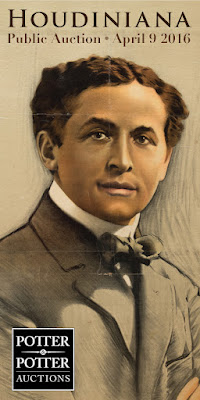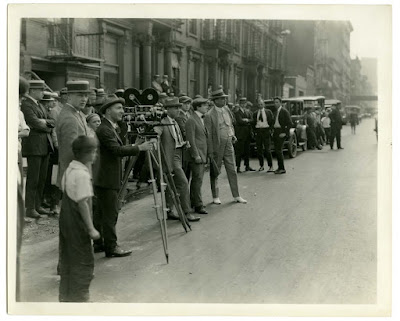"Apart from his amazing courage, he was remarkable for his cheery urbanity in every-day life. One could not wish a better companion so long as one was with him, though he might do and say the most unexpected things when one was absent." - Doyle on Houdini
Sir Arthur Conan Doyle, the creator of Sherlock Holmes, was a well-known believer and advocate of Spiritualism, a self-proclaimed religion in which one could communicate with the dead through a spirit medium. Even though Spiritualism had been around since 1848, the movement found new life after World War I, which had left so many dead on the battlefields and so many grieving loved ones wishing to make contact. The fact that esteemed men such as Sir Arthur Conan Doyle and Sir Oliver Lodge championed the movement also gave it great credibility.
Harry Houdini was skeptical of Spiritualism. His own interest in the subject dates back to his youth (not his mother's death, as is frequently depicted). In the 1890s, when Houdini was first setting out as a magician, the tricks of spirit mediums were the cutting edge magic of the day, and Houdini studied their techniques in books such as Revelations of a Spirit Medium. Houdini and his wife Bess even performed "Spiritualistic Entertainments" during their struggling years. Even after Houdini achieved his great fame as "The Handcuff King", he continued to study Spiritualism, accumulating a vast library on the subject. While he still held out hope there could be such a thing as a genuine medium, all he ever found was fraud.
The focal point of their new friendship was the subject of Spiritualism. Houdini told Doyle he was a "seeker of Truth" and "willing to believe." Doyle agreed with Houdini that there was fraud out there, but that he could send him to genuine mediums. While in the UK, Houdini claimed to have visited over 100 mediums, including those Doyle felt were genuine. But at every sitting, Houdini recognized trickery. The experience left him "further than ever from a belief in the genuineness of the manifestations."
But Doyle firmly believed that Houdini himself had supernatural powers, and cited as evidence a man who claimed to have felt Houdini dematerialize while doing his Milk Can escape -- "A great loss of physical energy was felt...such as is usually felt by sitters in materializing séances." Doyle famously wrote to Houdini: "My dear chap, why go around the world seeking a demonstration of the occult when you are giving one all the time?"
In 1922, Doyle came to the United States to lecture on the subject of Spiritualism. His lectures were a sensation in a "Jazz Age" that embraced the paranormal as fashion. Doyle even attended a special dinner hosted by Houdini for members of The Society of American Magicians. Showing a propensity for trickery himself, Doyle screened special effects footage from the in-production The Lost World. According to Doyle, the magicians were utterly fooled and believed he had somehow captured film of real dinosaurs.
But Doyle himself remained as gullible as ever. When Houdini playfully demonstrated a simple slight of hand trick in which he appeared to remove his thumb, Doyle was thunderstruck and once again proclaimed it as evidence of Houdini's paranormal powers.
In June of that same year, the Doyles invited the Houdinis to join them on a vacation in Atlantic City. While on the beach one day, Sir Arthur informed Houdini that Lady Doyle -- who had developed the power of mediumship herself -- was sensing that Houdini's deceased mother wished to communicate with him. Privately, Bess warned her husband that Lady Doyle had been peppering her with questions about his relationship with his mother just the day before. Nevertheless, Houdini agreed to the séance.
During the séance, held in Doyles suite at the Ambassador Hotel, Houdini's mother appeared to return via "automatic writing", a process in which Lady Doyle transcribed Cecelia Weiss's words from the beyond onto a note pad. Immediately, Houdini could see there where problems. The pages were in English, a language his mother did not speak. She also made the sign of the cross at the top of the first page. Not something one would expect from the wife of a Rabbi. The day before had also been his mother's birthday, something the spirit failed to mention. But Houdini concealed his doubts and thanked the Doyles for the séance.
Feeling challenged, Houdini began touring with his own lecture that was the flip-side of Doyle's popular talks. Houdini demonstrated the tricks of fraudulent mediums and denounced the very mediums Doyle supported. Doyle felt Houdini was being too vitriolic in his attacks. Houdini felt Doyle was being too naive. The strain became too much and their friendship collapsed with the publication of Houdini's book, A Magician Among the Spirits, in May 1924.
With no more fear of offending his former friend, Houdini ratcheted up his campaign against fraudulent spirit mediums and made a sensation of it (giving his career a boost after his lackluster stint in the movies). He attended séances in disguise and exposed mediums from the stage. He even testified before Congress in support of a bill that outlawed fortune telling. Doyle continued his own vigorous defense of Spiritualism, supporting mediums Houdini debunked, notably the famous Mina Crandon a.k.a. "Margery." He continued to express his belief that Houdini was a medium in denial. He even felt Houdini was putting himself in danger, saying "The spirit world might well be incensed against him [for] using psychic powers at the very time when he is attacking them."
Houdini now publicly ridiculed Doyle's gullibility, citing his support of the Cottingley Fairies as an example. (Two young girls claimed to have photographed fairies in their garden. Doyle wrote a full book in support of the phenomena, The Coming of the Fairies, before the girls admitted the fairies were cutouts from a picture book which, ironically, contained a story by Doyle.) Houdini even considered taking their feud to a new level by publishing a monograph showing how Doyle plagiarized Edgar Allan Poe in his Sherlock Holmes stories. Happily, Houdini's research didn't pan out and he dropped the idea.
After Houdini's sudden death in October 1926, Sir Arthur wrote Bess a heartfelt letter of condolence, ending with: "I am sure that, with strength of character (and possibly his desire to make reparation), he will come back." As thanks, Bess sent him a portfolio of artwork by Conan Doyle's father that Houdini had acquired in an auction. Doyle wrote her in return:
"The book arrived and filled me with surprise... It really seems like a series of miracles–first that it should exist still, then that it should cross the Atlantic, and finally that it should come back home. I accept it as a peace-offering from your husband, and I thank him as well as you."
Sir Arthur Conan Doyle died on July 7, 1930. He never wavered from his belief that his former friend was "the greatest physical medium of modern times."
So while Harry Houdini and Sir Arthur Conan Doyle never solved paranormal mysteries together, their famous friendship and feud forever links them in history, and it is nice to see the old friends reunited, if only in fiction.
For more on the real story of Houdini and Doyle, check out Masters of Mystery: The Strange Friendship of Sir Arthur Conan Doyle and Harry Houdini by Christopher Standford. Houdini & Doyle airs on FOX Monday's at 9 PM ET/PT.
Related:
- Adrian Conan Doyle on his father's belief in Spiritualism
- Review: Houdini and Conan Doyle by Christopher Sandford
- Link: That One Time Sir Arthur Conan Doyle Punked Houdini With Dinosaurs
- Mama's death and the birth of a myth
- Seance in Hanover Square
- Houdini, the Hillstreet, and the birth of a ghostbuster
- Houdini & Doyle - Believe It or Not!
- FairyTale: A True Story (1997)
























































